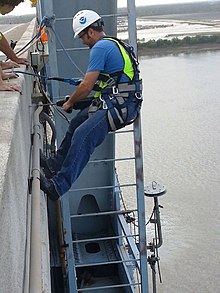This is an old revision of this page, as edited by Biggouldy3 (talk | contribs) at 14:21, 30 March 2018 (Included multiple paragraphs detailing the necessary testing and performance specifications of a full body harness manufactured to European standards.). The present address (URL) is a permanent link to this revision, which may differ significantly from the current revision.
Revision as of 14:21, 30 March 2018 by Biggouldy3 (talk | contribs) (Included multiple paragraphs detailing the necessary testing and performance specifications of a full body harness manufactured to European standards.)(diff) ← Previous revision | Latest revision (diff) | Newer revision → (diff)
A safety harness is a form of protective equipment designed to protect a person, animal, or object from injury or damage. The harness is an attachment between a stationary and non-stationary object and is usually fabricated from rope, cable or webbing and locking hardware. Some safety harnesses are used in combination with a shock absorber, which is used to regulate deceleration when the end of the rope is reached. One example would be bungee jumping.
In North America, Safety Harness for protection against falls from heights in industrial and construction activities are covered by design performance standards issued by ANSI (American National Standards Institute) in the United States and by CSA (Canadian Standards Association) in Canada. Specifically, the standards issued are ANSI Z359.1 and CSA Z259.10. These standards are updated approximately every four to five years so it is important to ensure the latest version is referenced.
Classifications
Fall Protection Systems
Listed below are different types of fall safety equipment and their recommended usage.
Class 1 Body belts (single or double D-ring) are designed to restrain a person in a hazardous work position to prevent fall or to arrest a fall completely within 3 foot of movement (OSHA). Amends must be made to keep the line rigid at all times. A harness should also be used.
Class 2 Chest harnesses are used when there are only limited fall hazards (no vertical free fall hazard), or for retrieving persons such as removal of persons from a tank or a bin.
Class 3 Full body harnesses are designed to arrest the most severe free falls.
Class 4 Suspension belts are independent work supports used to suspend a worker, such as boatswain's chairs or raising or lowering harnesses .
Uses
Safety harness types include:
- Seat belts.
- Child safety seats.
- Over-the-shoulder restraints used on roller coaster trains.
- A seat with a full body harness such as used by fighter pilots.
Occupations that may involve the use of safety harnesses include:
- Roofer
- Window washer
- Theatrical fly crew member
- Construction worker
- Crane operator
- Bridge painter
- Lineman
- Rock climber
- Motorsport
- Scaffolder
- Sailing
Testing and Performance
Full body harnesses used in industry and intended for the purposes of arresting a fall (used within the European Union) must comply to standard EN361:2002.
Full body harnesses are intended to hold the user and spread the load in the case of a fall arrest scenario (i.e. being brought to a stop following a period of free-fall). They are also designed, if the user becomes suspended, to keep them in a near upright position.
Necessary Performance in a Fall:
As part of the EN361 testing procedure; Full body harnesses must undergo a performance test under a shock load, simulating a person wearing the harness sustaining a fall. The test will include a 100kg solid torso dummy wearing a harness, alongside dynamic performance this also allows us to test the angle the wearer would be suspended at following a fall.
As part of the test procedure, the 100kg dummy wearing the harness will be attached to a 2 metre lanyard and released from the full 2 metre height above an anchor point. This will involve a minimum 4 metre fall distance. In order for the harness to comply with the standard the harness must hold the dummy successfully at an angle no greater than 50 degrees from the upright position. This test will be repeated twice on sternal and dorsal attachment points on the harness.
The maximum load a full body harness is ever expected to receive in a fall is 6kN. However as part of the European testing procedures,, to ensure an adequate factor of safety, harnesses are tested to withstand a 15kN tensile force applied in the upward direction followed by a 10kN force applied downwards.
All metallic components used within a full body harness are also tested for resistance to environmental corrosion (specifically rust).Products are held within a sealed chamber and subjected to a spray of salt water mist for 24-48 hours. Examinations are conducted for corrosion and function following this.
References
- Encyclopedia.com
- https://www.osha.gov/Region7/fallprotection/fall_protection_info.html
- "bestcarseatbooster.com". Tuesday, 4 July 2017
- https://www.rig-training.co.uk/Full-Body-Harnesses.php
Jones & Bartlett. Fire Fighter Skills. 2nd ed. Boston, Toronto, London, Singapore: Jones and Bartlett Publishers, 2009. pp243-244. Print.
External links
This technology-related article is a stub. You can help Misplaced Pages by expanding it. |